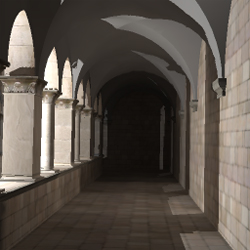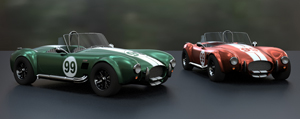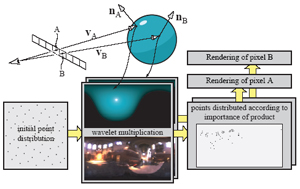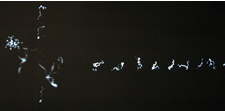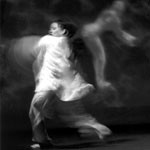Light Clouds, Camera Arrays and Virtual Rafts: Calit2 at SIGGRAPH 2005
|
7.28.05 - Nearly a dozen researchers affiliated with Calit2 are headed north to Los Angeles to participate in SIGGRAPH 2005. The leading annual conference and expo about computer graphics and interactive techniques takes place July 31 to August 4 at the L.A. Convention Center. This year's event will attract a broad array of attendees, including faculty and students from both UC Irvine, UC San Diego, other universities as well as industry leaders and film-makers.
Only 98 research papers were selected from 461 submissions. Four of the accepted papers were authored or co-authored by researchers in professor Henrik Wann Jensen's Computer Graphics Lab at UCSD and will be published in the Proceedings of ACM SIGGRAPH 2005 . Jensen -- a professor of Computer Science and Engineering in the Jacobs School of Engineering -- co-authored three of the papers.
|
"It is great that these papers got accepted for SIGGRAPH, which is the premier conference for computer graphics research," says Jensen. "The students have been working on these projects for a long time, and I am very happy that their hard work paid off."
Building on their previous work to improve the lighting of translucent objects such as skin, Jensen and Ph.D. candidate Craig Donner are now tackling the diffusion of light in multi-layered translucent materials. "We are presenting a new and efficient technique to account for diffusion in thin slabs such as a leaf where some of the light may exit the leaf rather than being completely absorbed or reflected," says Donner. "We then extended this theory and applied it to multi-layered materials such as human skin, paint or paper."
Professor Jensen -- who shared an Academy Award last year for a light-diffusion technique first presented at SIGGRAPH 2001 -- also co-authored two other new papers to be presented in Los Angeles.
|
Working with research assistant Anders Wang Kristensen and Lund Universitycollaborator Tomas Akenine-Möller, Jensen's paper on Precomputed Local Radiance Transfer for Real-Time Lighting Design introduces a new method for real-time relighting of scenes illuminated by local light sources.
The researchers are introducing the concept of unstructured light clouds -- a compact representation of local lights in the model (watch video at right). "Our results demonstrate real-time rendering of scenes with moving lights, dynamic cameras, glossy materials and global illumination," explains Jensen. "The system handles indirect illumination efficiently for models with more than 100,000 triangles, so our algorithm offers a practical alternative to the traditional techniques used in real-time graphics."
Jensen's third paper to be presented at SIGGRAPH 2005 is titled Wavelet Importance Sampling: Efficiently Evaluating Products of Complex Functions . His co-authors are UCSD grad student Wojciech Jarosz, Lund's Akenine-Möller and Petrik Clarberg (Lund and UCSD).
|
'Importance sampling' is a mathematical technique to select a good distribution from which to simulate random variables, and is widely used in computer graphics for modeling lighting and other elements of a scene. For instance, it is now commonly used with bidirectional reflectance distribution function (BRDF), a measure of how much light is reflected when light makes contact with a certain material. But current techniques are limited because they do not efficiently permit modeling the lighting of scenes that may change over time.
The authors will present a new technique for importance sampling products of complex functions using wavelets. "We show how the product can be sampled on-the-fly without the need of
|
One application of the new sampling technique is rendering of objects with measured BRDFs illuminated by complex distant lighting. "Our results demonstrate how the new sampling technique is more than ten times more efficient than the best previous techniques," adds Jarosz. "In contrast to previous work, our method is capable of efficiently importance sampling the product of the lighting and the BRDF."
|
Another member of Jensen's team, Ph.D. student and research assistant Neel Joshi, co-authored a paper on high-performance imaging using large camera arrays. His co-authors on that paper -- featured in the SIGGRAPH session "Capturing Reality" -- are from Stanford University, where Joshi received his M.S. in 2004. They explore a range of applications that become possible with the advent of inexpensive digital image sensors. "This changes how we think about photography," report Joshi and his co-authors. "Our goal was to explore the capabilities of an array of 100 custom video cameras that would be inexpensive to produce in the future." The research also assumes cheap and easy processing of large numbers of images, and the ability to create photographs that combine information from a number of sensed images.
Members of UCSD's Computer Graphics Lab are also looking ahead to next year's SIGGRAPH. Matthias Zwicker of MIT is joining the Jacobs School faculty as the lab's second full-time professor, and Zwicker is the co-author of two papers at SIGGRAPH 2005.
Emerging Technologies
Calit2 researchers will also have a high-profile presence in SIGGRAPH's "Emerging Technologies" program, chaired by Donna Cox of the National Center for Supercomputing Applications at the University of Illinois, Urbana-Champaign. (Cox is a participant in the Calit2-led OptIPuter project.)
|
The program was organized in part by UCSD's Ruth West, whose pioneering work in "bioart" derives new media from scientific data. West and her colleagues at the UCSD-based National Center for Microscopy and Imaging Research (NCMIR), David Lee and Steve Lamont, along with colleagues from UCLA and USC, will showcase their Ecce Homology. The exhibit is a physically interactive new-media work that visualizes genetic data as calligraphic forms. (For more on the Ecce Homology, click here for a preview of the SIGGRAPH exhibit or see Related Links below.)
|
Also on display as part of the Emerging Technologies program is the Virtual Raft project, led by UC Irvine professor and Calit2 participant Bill Tomlinson. He will invite attendees to play with a network of mobile and stationary computer systems inhabited by communities of interactive animated agents. Based on research with UCI graduate student Man Lok Yau and MIT's Jesse Gray, Tomlinson will demonstrate his method for enabling a real-time animated character to appear to jump between a stationary computer screen and a mobile graphical device. A tablet PC acts as a "virtual raft" that can carry animated agents between "iLands" -- screens of PCs where the animated characters originate. The project features innovations in heterogeneous computer graphics, tangible human-computer interaction, interactive animated characters, and mobile computing technology. It has applications in education, entertainment, and new-media art.
|
SIGGRAPH also features leading-edge research on the integration of performing arts and technology. In the "Sketches" program, UC Irvine professor of dance and media arts John Crawford will present a short paper titled Active Space: Embodied Media in Performance , describing the interactive performance work from the Claire Trevor School of the Arts that dazzled anyone who participated in the dedication ceremonies this spring for Calit2's new building at UCI. Developed in collaboration with UC Irvine professor Lisa Naugle, the Active Space is an interactive physical environment for dance, theater and music performance. As the system responds to movement, participants engage its behaviors and "play the space" as an instrument.
Related Links
SIGGRAPH 2005
Light Diffusion in Multi-Layered Translucent Materials
Precomputed Local Radiance Transfer for Real-Time Lighting Design
Wavelet Importance Sampling: Efficiently Evaluating Products of Complex Fun
High-Performance Imaging Using Large Camera Arrays
Ecce Homology
Virtual Raft
Media Contacts
Media Contact: Doug Ramsey, (858) 822-5825, dramsey@ucsd.edu



